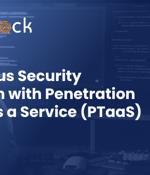Security News

Network penetration testing plays a vital role in detecting vulnerabilities that can be exploited. The current method of performing pen testing is pricey, leading many companies to undertake it...

CloudFoxable is a capture-the-flag style learning platform you can deploy to your playground AWS account. It primarily targets current penetration testers seeking to learn exploitation of cloud-native attack paths, and cloud security experts aiming to practice offensive security techniques safely.

The purpose of this policy from TechRepublic Premium is to provide guidelines for appropriate penetration testing and scanning of computer systems and networks. Penetration tests can be basic, checking for systems not protected by passwords, for instance.

The benefits of continuous validation combined with penetration testing can be a force multiplier for audit-readiness, incident preparedness, and fortified defenses. As security leaders seek new solutions to improve security outcomes and prevent breaches, they are looking at the testing aspect to improve compliance while validating security.

Pen testing helps to identify security flaws in your IT infrastructure before threat actors can detect and exploit them. Here, we outline key factors to consider before, during, and post the penetration testing process.

SpecterOps released version 5.0 of BloodHound Community Edition, a free and open-source penetration testing solution that maps attack paths in Microsoft Active Directory and Azure environments. "The way that BloodHound Community Edition maps out Attack Paths in AD and Azure is unique - there isn't another tool that can find hidden and unintentional relationships to identify complex Attack Paths that attackers can exploit. After this update, the tool will offer a user experience closer to an enterprise-grade product than an open-source tool," Andy Robbins, co-creator of BloodHound and a Principal Product Architect at SpecterOps, told Help Net Security.

Red Siege has developed and made available many open-source tools to help with your penetration testing work. The company plans to continue to support the tools listed below, whether in the form of bug fixes or new features.

Penetration testing is an essential tool for identifying, analyzing, and mitigating security risks. Mobile app penetration testing: analyzes the security of an organization's mobile applications, looking for mobile-specific security issues that could be used by attackers.

Among these tools, Burp Suite stands out as one of the most popular and widely used options among security professionals and enthusiasts alike. Here's a collection of Burp Suite extensions to make it even better.

People frequently confuse penetration testing and vulnerability scanning, and it's easy to see why. Penetration testing is a manual security assessment where cyber security professional attempts to find a way to break into your systems.